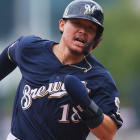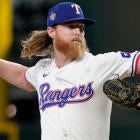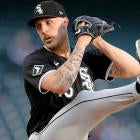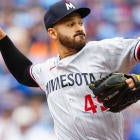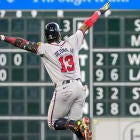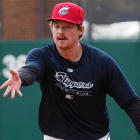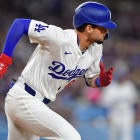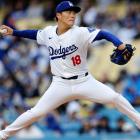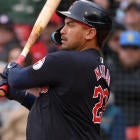I've often said that the prospect who gets sent back down generally isn't as worth stashing the second time around. It has nothing to do with ability or probability and everything to do with perception. He already has the stench of failure on him, so your opposition won't be as eager to scoop him up the next time he gets the call.
Keston Hiura might be an exception. For one thing, it's not so clear he actually did fail. For most of Travis Shaw's absence with a strained wrist, yes, it looked like Hiura was overmatched, with a 23-to-3 strikeout-to-walk ratio summing up much of his big-league experience. That's over 17 games, so yeah ... not good.
But in the days leading up to Shaw's return, Hiura caught fire, homering three times in his final five games. In the end, his numbers looked like this:
Which are in stark contrast to Shaw's:
With that late surge, the Brewers could have justified turning the page on Shaw and entrusting second base to Hiura now and forever, but Shaw is an interesting case, a back-to-back 30-homer man who appeared to be on the upswing before he forgot how to make contact this year. Thus, it's also reasonable that the Brewers wouldn't want to give up on him so soon, especially since Hiura was indeed showing his own weaknesses.
One interesting point about those weaknesses, though: Hiura has already demonstrated an ability to adjust. He had 27 strikeouts to one walk in his first 16 games at Triple-A this year compared to 16 strikeouts and 14 walks in his next 22. Strikeouts aren't supposed to be a big part of his game, and I suspect if he had stayed in the bigs, they would have dwindled in a similar fashion.
So I'll be genuinely excited when he gets the call again, especially since second base has been one of the few positions I've struggled to fill this year. I wouldn't say he's as much of a slam dunk as Yordan Alvarez, but don't be surprised if, in the weeks ahead, he shows up in my ...
Five on the verge
(These are the prospects most worth stashing in redraft leagues.)
Yordan Alvarez, OF, Astros
2018 minors: .293 BA (335 AB), 20 HR, 21 2B, .904 OPS, 42 BB, 92 K
2019 minors: .353 BA (204 AB), 22 HR, 16 2B, 1.205 OPS, 36 BB, 46 K
So far, the loss of George Springer and Carlos Correa, both of whom recently joined Jose Altuve on the IL, hasn't compelled the Astros to turn to their top minor-league assets for more offense, content to ride out second-tier types like Derek Fisher and Myles Straw. And when they've won five of six, who can blame them? GM Jeff Luhnow doesn't sound like a man feeling the heat:
Jeff Luhnow on Yordan Alvarez: "The reality is, right now, we have Michael Brantley playing left field and (Alvarez) hasn't really shown us he can play first base ... There's no real need or urgency to bring him up, but it's only a matter of time."
— Chandler Rome (@Chandler_Rome) June 2, 2019
It'll happen — only a matter of time, like Luhnow says. And with each week, that time draws nearer. To what extent the defensive concerns are just a convenient excuse while the Super 2 issue is still in play is hard to say, but it's not like the Astros have a dedicated DH. And there's no case to be made for Alvarez's bat not being ready.
Kyle Tucker, OF, Astros
2018 minors: .332 BA (407 AB), 24 HR, 20 SB, .989 OPS, 48 BB, 84 K
2019 minors: .254 BA (205 AB), 18 HR, 13 SB, .921 OPS, 22 BB, 51 K
Luhnow isn't commenting as much about Tucker as Alvarez, but it may have more to do with the questions he's being asked than his personal views on the pecking order. Most publications rated Tucker the better prospect of the two coming into the year. He's already on the 40-man roster and is at least an adequate defender. You could make the case he's the more logical choice, then, to get the call when the time comes, especially since he's batting .326 with 16 homers, 10 steals and a 1.177 OPS in his past 35 games — Alvarez numbers, basically. His impact potential may be higher, too, given that he steals bases, so certainly in Rotisserie leagues, he should already be stashed away.
Zac Gallen, SP, Marlins
2018 minors: 8-9, 3.65 ERA, 1.47 WHIP, 133 1/3 IP, 48 BB, 136 K
2019 minors: 8-1, 1.67 ERA, 0.69 WHIP, 81 IP, 15 BB, 99 K
Those awaiting the outing when Zac Gallen comes back down to earth will await it another week. He allowed one earned run over seven innings in his most recent start Tuesday, equaling his season high with 11 strikeouts. Only once in 12 starts has he allowed more than two earned runs; only once has he thrown fewer than six innings; and only twice has he allowed more than four hits. He wasn't so highly regarded coming into the year, which makes this level of dominance a bit fishy still, and it's reasonable to wonder how his stuff will translate to the majors. But clearly, he deserves the chance to find out, and seeing as every Fantasy player could use another starting pitcher, he'll get the benefit of the doubt from when that chance comes.
Jesus Luzardo, SP, Athletics
2018 minors: 10-5, 2.88 ERA, 1.09 WHIP, 109 1/3 IP, 30 BB, 129 K
2019 spring: 0-0, 0.93 ERA, 1.03 WHIP, 9 2/3 IP, 4 BB, 15 K
Luzardo's rehabilitation of a strained rotator cuff keeps moving ahead without much fanfare. He threw a 30-pitch simulated game Sunday, which should mean he isn't too far from an honest-to-goodness rehab assignment. At that point, we're looking at maybe as little as a month until he's starting games in the big leagues. I suppose it depends how close you believe the A's think he is to major league-ready, but he looked well on his way to securing a rotation spot before suffering the injury this spring. This injury could be sort of a blessing in disguise if it allows him to close out the season without coming up against any sort of innings cap.
Luis Urias, 2B, Padres
2018 minors: .296 BA (450 AB), 8 HR, 30 2B, .845 OPS, 67 BB, 109 K
2019 minors: .361 BA (169 AB), 14 HR, 11 2B, 1.167 OPS, 27 BB, 37 K
What the heck, San Diego? Sure, Urias went 2 for 24 during a brief stint in the majors earlier this season, but what does he need to do at Triple-A to get another shot at replacing the corpse of Ian Kinsler? Because surely, he's done all he can do, demonstrating far more home run power than at any other point in his minor-league career while still delivering the 11th-best batting average among all minor-leaguers. The Padres are in the thick of the wild card race, too. Playing the service-time game could cost them a opportunity at their first playoff appearance since 2006, and as much as they've already held Urias back, it's not clear what they still have to gain on the service-time front anyway. Just please, give me a chance to write about someone else.
Five on the periphery
(These are some other prospects doing something of note.)
Luis Robert, OF, White Sox
2018 minors: .269 BA (186 AB), 0 HR, 15 SB, .694 OPS, 12 BB, 52 K
2019 minors: .382 BA (204 AB), 11 HR, 18 SB, 1.124 OPS, 11 BB, 47 K
Once Alvarez and Tucker move up, there's a good chance Robert is the top remaining bat in the minors. That's how much his stock has risen following an injury-plagued year in which we now know his power was compromised. His transition to Double-A back at the start of May was a little bumpy at first, but he's batting .438 (28 for 64) with seven doubles, two triples, a homer and five steals over his past 14 games. A couple more weeks like that, and he may be on his way to Triple-A, which would of course put him within spitting distance of the majors. Here's the thing: The hitting profile still doesn't look nearly as advanced as Eloy Jimenez's did at this time a year ago, and if the rebuilding White Sox resisted the urge to call him up all year, I have to think they'll do the same with Robert.
Ryan Mountcastle, 3B, Orioles
2018 minors: .297 BA (394 AB), 13 HR, 19 2B, .806 OPS, 26 BB, 79 K
2019 minors: .322 BA (205 AB), 11 HR, 13 2B, .900 OPS, 7 BB, 48 K
Mountcastle is a fine prospect, but not of the sort of franchise-altering potential that would compel a team to hold him back for economic reasons. Once he has maxed out his potential at Triple-A, it stands to reason the Orioles will give him a shot, as many holes as they have in their lineup. And he appears to have maxed out his potential at Triple-A, continuing his power breakthrough with a three-homer game Sunday. He's a hitter, but he's also a hacker with minimal on-base ability apart from the batting average. It limits him from being a true stud in Fantasy, but he could be a relevant contributor as early as this season.
Jarren Duran, 2B/OF, Red Sox
2018 minors: .357 BA (283 AB), 3 HR, 24 SB, .910 OPS, 16 BB, 48 K
2019 minors: .386 BA (207 AB), 4 HR, 18 SB, .996 OPS, 24 BB, 46 K
Duran is such an awkward fit for the modern game that I hesitate to call him a prospect, but when a guy hits .390 over two months' time, you have to take your head out of the sand. Of course it's unsustainable. He might only be the .360 hitter he was a year ago. OK, so both marks have depended on a BABIP over .400, but he's a line-drive, all-fields hitting throwback who might just amount to something in Fantasy if allowed to run like he has in the minors (which is no guarantee). Of course, the modern game also assumes some power development for most any player with a plus hit tool, so maybe he ends up being sort of a poor man's Andrew Benintendi.
Rico Garcia, SP, Rockies
2018 minors: 13-9, 2.96 ERA, 1.17 WHIP, 167 IP, 42 BB, 162 K
2019 minors: 7-1, 1.92 ERA, 0.90 WHIP, 61 IP, 18 BB, 81 K
Though only 5-feet-11, Garcia learned to incorporate his whole body in his delivery last year, which led to a jump in velocity and, with it, production. Continued improvement of his secondary arsenal has made him one of the minors' top strikeout pitchers this year. Most recently, he threw six no-hit innings Tuesday, striking out 11. I feel like a Pablo Lopez comp makes sense here since Lopez himself only began to dominate at the upper levels, but Garcia of course will have a much tougher home environment. Already 25, Garcia could make his debut later this season.
Damon Jones, SP, Phillies
2018 minors: 10-7, 3.41 ERA, 1.37 WHIP, 113 1/3 IP, 50 BB, 123 K
2019 minors: 3-3, 1.37 ERA, 1.01 WHIP, 52 2/3 IP, 22 BB, 80 K
Before you get too excited, note that Jones is a 24-year-old pitching at high Class A, so it stands to reason he's more advanced than his competition. Still, the same would have been true at low Class A last year, and he wasn't dominating like he is now, his 13.7 strikeouts per nine innings ranking seventh in all the minors. With a fastball that sits in the mid-90s, which is particularly notable for a left-hander, and a true four-pitch arsenal, Jones should be tested against more advanced competition soon enough, and if he passes that test, you might start hearing more about him.

















